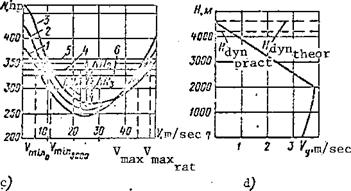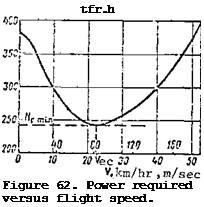Landing is transitional flight from a height of 25 – 50 m with reduction of the velocity and subsequent touchdown. Helicopter landing may be performed in helicopter style, in airplane style, in the autorotative regime, from a glide along an inclined trajectory, and with flare-out.
The helicopter-style landing is the primary technique for landing with the engine operating. It includes the following stages (Figure 91):
(1) glide with reduction of the speed along the trajectory and vertical rate of descent;
(2) hover at a height 2 – 3 m above the landing area;
(3) vertical descent;
(4) touchdown.
During the landing approach the helicopter performs steady-state descent along an inclined trajectory with the engine operating. At a height of 40 – 50 m reduction of the speed along the trajectory is initiated while maintaining a constant descent angle. In this stage the motion of the helicopter is governed by the following conditions:
О > O’
77/’//У/У//77Ї7УУ’ "/7/ / 77^/~ґ7?~77^7/УУ777У/у///’//////////У/У///,
і О*
|
Figure 90. Takeoff on air cushion.

|
Figure 91. Helicopter-type landing.
Y = G^ = G cos 0 (constant descent angle);
P + X > G_ (reduction of the speed); x par 2
T = S (absence of lateral displacement); t. r s
M = M and EM = 0 (constant direction of flight, i. e., absence of r t. r eg
rotation about the helicopter’s primary axes).
Deceleration of the helicopter is achieved by tilting the main rotor
thrust force vector aft and increasing the thrust component P. Upon reaching
a speed of 50 – 60 km/hr, the vertical rate of descent is reduced by increasing main rotor pitch and its thrust force. The helicopter deviates from the descent path angle and travels parallel to the surface of the ground at a height of 2 – 3 m. During this inertial motion the speed decreases to zero and the helicopter hovers above the landing area, orienting itself relative to the center of the area. If the landing approach was not made directly into the wind, the helicopter is turned about the vertical axis to take up a heading into the wind. Then a vertical descent is made at a low rate in order to avoid rough contact of the wheels with the ground.
The airplane-type landing is made under the same conditions as the takeoff of the same type. It includes the following stages (Figure 92): glide
from a height of 15 – 30 m, flare, holdoff, touchdown, and rollout. During the descent altitude is lost, but a constant speed and descent angle are maintained. The descent is made with the engine operating. The flare is initiated at a height of 7 – 10 m by increasing the thrust and lift forces.
|

touchdown and rollout. transition1 flare’ glide
|
Figure 92. Airplane-type landing.
The flare is terminated at a height of 1 – 0.5 m and the horizontal component of the velocity diminishes at this point, since the weight force component decreases to zero. After the flare the helicopter still has a relatively high speed, which is then reduced during the holdoff period. The
touchdown is made on the main gear wheels at a speed of 30 – 40 km/hr. In this procedure care must be taken that the tail does not get too low, since damage to the tail skid and the tail rotor can occur. The touchdown is followed by rollout, during which the main rotor thrust is decreased. An airfield or a smooth area with firm soil is necessary for the airplane-type landing.
Landing under special conditions. If the landing area is surrounded by obstacles, a helicopter-type landing is made without utilization of the "air cushion." Hovering is performed into the wind at a height of 5 – 10 m above the obstacles to align the helicopter with the center of the area. Then a vertical descent is made at a rate of descent of no more than 2 m/sec in order to avoid the vortex ring state. During this descent the vertical velocity of the helicopter is reduced to 0.2 – 0.3 m/sec at the moment of touchdown. Therefore, this type of landing can only he made if there is sufficient power margin available for hovering outside the "air cushion" influence zone. This type of landing is used only in case of extreme urgency, since a safe landing is not guaranteed in case of engine failure at a height of more than 10 m (in the danger zone).
Landing in the main rotor autorotation regime with glide along an inclined trajectory. We have established above that in case of engine failure flight in the main rotor autorotation regime should be made along an inclined trajectory rather than vertically.
Landing from a glide along an inclined trajectory is similar to the landing of an airplane and requires a smooth area with solid ground. It consists of the following stages (Figure 93):
(1) glide at constant angle and constant speed;
(2) deceleration (reduction of glide angle and vertical rate of descent through use of the kinetic energy of the helicopter and the main rotor);
|
Figure 93. Autorotative landing.
|
|

(3) touchdown;
(4) rollout and reduction of main rotor pitch.
The advantage of this landing is that the helicopter has considerably less /147 vertical velocity and better controllability. In addition, during flight along the inclined trajectory the helicopter has considerable kinetic energy, which is used to reduce the vertical velocity prior to touchdown. Therefore, the landing is safer and simpler when the helicopter approaches in a glide along an inclined path. This type of landing utilizes the kinetic energy of the entire helicopter, as well as the kinetic energy of the main rotor.
During the glide a constant descent angle is assured by the condition
У — Gt = G CO? 0,
and constant velocity is assured by the condition (see Figure 92)
 X + P. par x‘
X + P. par x‘
The gliding speed is close to the economical speed for level flight, but it changes as a function of the wind velocity and direction. When gliding і nto the wind the helicopter speed should be higher, the higher the wind velocity.
The height for initiation of the deceleration or flare is different on different helicopters: the higher the disk loading, the higher this height.
For example, this height for the Mi-1 is 15 – 20 m; for the Mi-4 it is 25 – 20 m. Deceleration is obtained by tilting the main rotor coning axis aft. This leads to increase of the main rotor angle of attack and increase of the angle of attack of each blade element, which then leads to increase of the main rotor thrust force and its rpm. Therefore, both the glide angle and the velocity along the trajectory decrease. After the coning axis is deflected aft, the main rotor collective pitch must be increased to the maximal value. This leads to further increase of the thrust force and reduction of the vertical rate of descent. The helicopter will travel for some time parallel to the ground surface, similar to the motion of an airplane during transition. The height at the end of this motion decreases to 0.5 – 0.3 m and the helicopter touches down with vertical velocity close to zero.
During the flare and transition the helicopter nose is high. Touchdown cannot be made in this attitude because of danger of damage to the tail rotor. Therefore, prior to touchdown the helicopter’s nose is lowered by deflecting the cyclic control stick forward. The increase of main rotor pitch leads not only to increase of the thrust force, but also to increase of the resistance to rotation; the rotor rpm decreases and the coning angle increases (blades flap up). If the rotor pitch is not reduced after touchdown, the rotor blade may descend abruptly and strike the tail boom.
Landing in the autorotative regime with vertical descent. If the landing /148 is made on a small area which is surrounded by obstacles, the landing must be made from a vertical descent. It was established earlier that the vertical rate of descent during flight in the autorotative regime along a vertical
trajectory is found from the formula = 3.6 tF and amounts to 14 – 20 m/sec.
Touchdown at such a velocity leads to damage to the helicopter and does not guarantee safety of the crew. Therefore, the velocity is reduced prior to touchdown by utilizing the kinetic energy of the main rotor. Such a landing is called a landing with flare-out. The essence of the operation is as follows.
At a height of 20 – 25 m the main rotor pitch is increased to the maximal
value, and the main rotor rpm should be as large as possible in order to
impart maximal kinetic energy to the main rotor (the kinetic energy is propor – 2
tional to to ). As the pitch is increased there is a marked increase of main rotor thrust flare-out, which leads to reduction of the vertical rate of descent to 3 – 5 m/sec. Such a velocity can be abosrbed completely by the gear shock absorbers, and a safe landing can be made.
The landing is easier when there is a wind. In this case the helicopter is turned into the wind and transitioned into the inclined glide regime (slope 45°). The effect of the wind is to carry the helicopter aft, and its trajectory relative to the ground will be nearly vertical. The helicopter controllability is better in this type of glide, and the thrust force is increased somewhat as a result of forward flight.
A vertical landing in the autorotation regime requires considerable skill and coolness on the part of the pilot. The following errors are possible in this type of landing:
(1) early flare-out (reduction of vertical velocity at a high altitude);
(2) late flare-out, as a result of which the vertical velocity is not reduced and hard contact with the ground may result.
It is clear from this discussion that the velocity is not entirely arrested in landing from a vertical descent. Even when the flare-out is
performed correctly, the final velocity may be quite large — 3-5 m/sec or more. This is explained by the fact that the helicopter, which has a rate of descent prior to flare-out of 15 – 20 m/sec, has considerable kinetic / C7V?
energy! s= —2^eSj • e4uiva3-ent kinetic energy of the main rotor must be
expended to arrest the vertical velocity completely. But the main rotor
kinetic energy is not entirely utilized for braking the helicopter. A large
part of the rotor energy is expended in overcoming the profile and induced
drags, on friction in the transmission, and on the blade end losses. Only
one fifth or sixth of the total kinetic energy of the main rotor is used for
deceleration. This means that the main rotor must have 5-7 times the kinetic /149
energy of the helicopter in order to decelerate the helicopter completely.
In reality the main rotor kinetic energy is about three times the helicopter kinetic energy.
Therefore, the vertical velocity cannot be arrested completely, but it must be reduced as much as possible, and to this end the main rotor rotational energy is increased; this energy is proportional to the blade mass and the square of the angular velocity of revolution
where is the rotational kinetic energy;
j is the main rotor moment of inertia;
 9.b’L p~
9.b’L p~
JV •
Substituting the value of the rotational moment of inertia into the formula, we obtain
We see from the formula that heavier blades are required for safe landing in the autorotation regime.
CHAPTER XI























